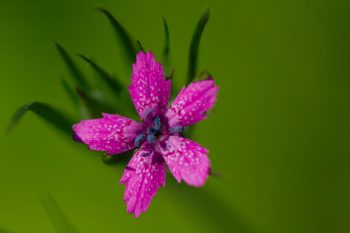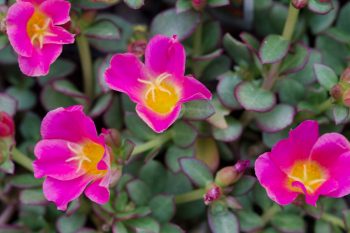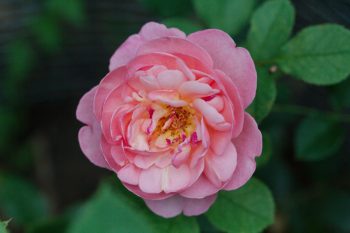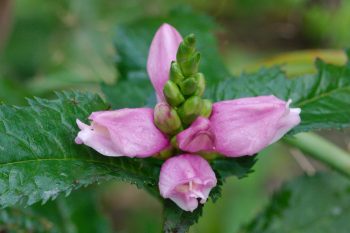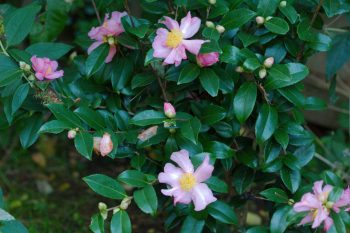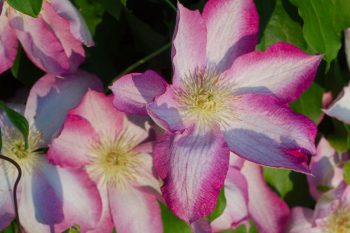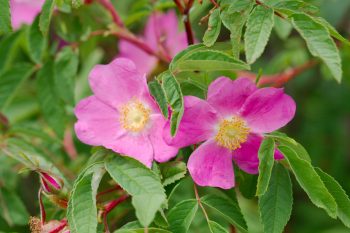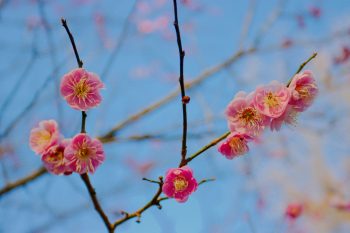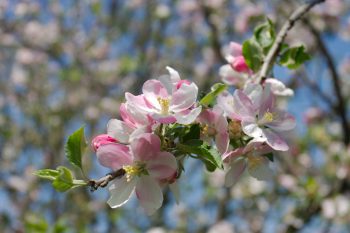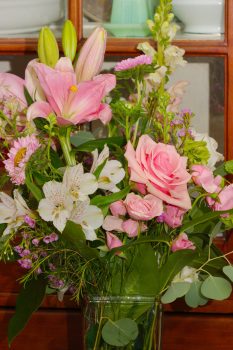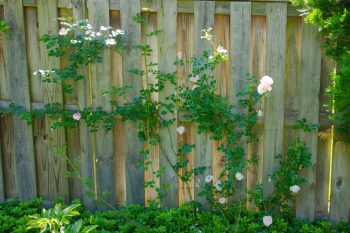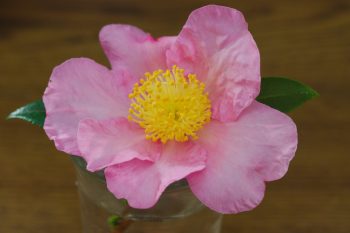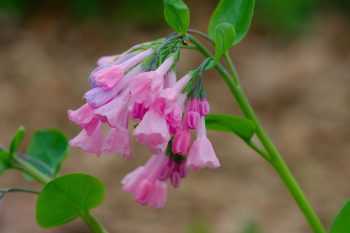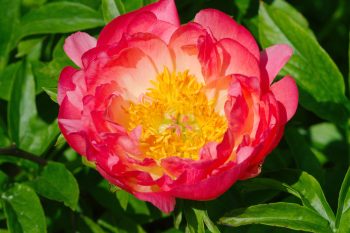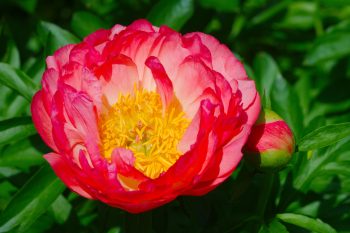This is a pretty little flower that’s starting to appear in our garden. It is Dianthus armeria, the so-called Deptford Pink, native to Europe and not naturalized over much of North America. It is an annual or biennial and grows between two and three feet tall with very thin stems topped by these lovely little pink flowers, which are about a centimeter across. It self seeds pretty well but isn’t aggressive enough to be a problem at least in our garden. Most of those we have are growing in containers on the driveway or around that area.
Tagged With: Pink
Dianthus armeria (Deptford Pink)
Purslane
Purslane, otherwise known as Portulaca oleracea subsp. sativa, is a pretty, flowering annual plant native to India. It is hardy and will self-seed if conditions are right although we generally need to buy more each year. This one is called ‘Pizzaz Nano Fuchsia’ and it’s pretty hot pink. It is an edible plant, used as a salad green or even cooked in stews in some places, although we’ve never tried it ourselves. I might give it a try, but I generally enjoy it well enough in the garden that I think I’ll leave most, if not all, of it there.
Rose ‘Boscobel’
This is the third of my three new roses planted this year. This isn’t its first bloom although it did take longer than the other two did to bloom. That has more to do with the rabbits nipping off the buds than anything else. It now has a hardware cloth fence around it and it’s doing much better. This one is planted near the back fence and should be visible from the house once it gets a bit taller. I have high hopes for all three of these roses and was glad to get them planted back in mid-May.
Chelone lyonii (Pink Turtlehead)
We’ve only had this native perennial a few years and this is by far the best it’s done in our garden. We have it in a somewhat shady area. Over time it should spread and form a clump, although not so much that it could be considered invasive (like much of what we have). The snapdragon-like flowers are fairly large and as you can see, they are borne in tight, spike-like terminal racemes. They are actually native to a bit further south than we are but have become naturalized over much of the east coast.
Anemone hupehensis var. japonica ‘Pamina’
We bought this Japanese anemone last year and it was in a pot over the winter. I planted it this spring and for a while it looked like the rabbits were not going to let it grow or bloom. Eventually I put a fence of hardware cloth around it, which they quickly knocked over. Now it’s staked to the ground with tent pegs and isn’t going anywhere. I’m a little bothered by the background in this, where the hardware cloth gives a regular, if out-of-focus pattern. Anyway, the anemone is quite lovely and I’m pretty happy with it. Hopefully it will get well enough established that we can take down the fence.
Camellia x ‘Winter’s Star’
I bought this camellia, called ‘Winter’s Star’, from Camellia Forest and planted it along the fence at the north end of our back garden. It’s doing well and is coming into bloom. This is a cross between Camellia oleifera and Camellia hiemalis ‘Showa-no-sakae’ and as you can see, it has single, pink flowers and is a fall bloomer. It’s only three or so feet tall at this point, but it should get large enough to be a really striking fall feature in that part of the yard. I bought and planted two other camellias at the same time. These others are both C. japonica and are called ‘Hokkaido Red’ and ‘April Rose’, both spring bloomers.
Pink Hydrangea
When fresh, the flowers on this hydrangea are mostly white with a touch of pink on the edges. As they dry out, however, some of the petals deep in color to a dark pink, bordering on red. It’s not as showy as some flowers and overall, the plant is moving into winter mode. Nevertheless, the color of the petals is quite nice, especially when the late afternoon or early evening sun is shining on them. The deer have done considerable damage to this plant over the years but it keeps fighting back and had a good run this year. Hopefully that will continue.
Clematis
We took a walk in the neighborhood this evening and I took this photo of a clematis growing on a mailbox a few blocks over. Whether you pronounce it KLE-ma-tas or kle-MA-tas, it’s a pretty thing. We have a few of them but none are doing exceptionally well. One doesn’t get enough sun (it was there when we bought the house and we talk about moving it but so far it hasn’t happened). Another was overshadowed by a rose bush. The rose is gone now but the clematis needs a bit more support than it has.
Rosa davurica (Amur Rose)
Back in April of 2005 I planted 29 species roses in a bed I prepared on our property in Pennsylvania. Sadly, many of them did not survive, but there are a few that are still holding on and two that are actually thriving. This is one of those. It is, I think, Rosa davurica although the garden is in such bad shape, it’s not exactly clear where each rose should be. This rose has formed a small mound of plants about four feet tall and it is very happy. It’s absolutely covered with blooms and is quite lovely.
Early Cherry Blossoms, McCrillis Garden
We picked up Dorothy today and went to McCrillis Garden on Greentree Road this afternoon. It’s a wonderful little garden (five lots totaling about 4.8 acres) that’s especially lovely when the azaleas and rhododendrons are in bloom. But it’s worth a visit at other times of the year, as well, to see the sometimes less spectacular but still lovely plants. At the north end of the property there were a few cherry trees beginning to bloom. We also enjoyed seeing some of the ‘bones’ of the garden, including trees that have interesting shapes and structure even when they don’t have leaves. But seeing the blossoms was particularly nice.
Camellia japonica ‘Pink Perfection’
Last year’s cicada swarm did some serious damage to two of my camellias as well as to the two dwarf apple trees. They all survived, but I wouldn’t say any of them are thriving yet. There are a few flowers on this plant, Camellia japonica ‘Pink Perfection’, which was planted in the spring of 2010. It’s still only about three feet high, which is disappointing, but at least it’s still alive. ‘Dad’s Pink’, planted two years later, has even fewer blooms and I’m not 100% sure it’s going to survive. The healthiest camellia I have at this point is ‘Hokkaido Red’, planted only two years ago and in a spot well protected from both the cold wind and from deer.
Apple Blossoms
As mentioned in my preview post, we wanted to be outdoors today because it was so nice. We went to the Agricultural History Farm Park and after going through the woodland garden and the Master Garder’s Demonstration Garden, we walked around one of the fields adjacent to the central part of the farm. Between two fields there is a line of a dozen or so apple trees and they were in bloom, which was a really nice bonus. I don’t know how much car these trees get but it appears to be the right amount, at least in terms of their flowering. They were absolutely lovely and the bees and other pollinators were a buzz.
Flower Arrangement
Margaret had a visitor today who brought her this lovely flower arrangement. Writing this now over a month after the fact, the arrangement is gone, of course, but it lasted a surprisingly long time and was on the table next to Margaret for all that time. It was such a thoughtful thing to bring and of course, the visit was a blessing, as well. If anyone wants to visit her, don’t hesitate to give her a call. You don’t have to bring flowers, naturally, but we’re not going to turn them down if you do.
Sometimes Margaret will tell us to put them in the kitchen or dining room where we can see them but lately we’ve been ignoring her and leaving them in her room. They were brought for her, after all, and she really should get the benefit of them. We’re in that part of the year when things are blooming in the yard, so we’re not short of flowers ourselves, anyway. I have three new roses this year and the first of those is starting to bloom, which is really nice.
Rose ‘Dr. W. VanFleet‘
A few years ago my cousin Lyn rooted a rose that’s been growing in his yard for many, many years. It grows and blooms prolifically and it’s become established on our back fence. We had a few flowers on it last year and more this year. Although it looks like ‘New Dawn‘ it only blooms once, so I’m guessing that it is ‘Dr. W. VanFleet‘, of which ‘New Dawn‘ is a repeat flowering sport. ‘New Dawn‘ has the distinction of having plant patent number 1 (October, 1931) and it shares with ‘Dr. W. VanFleet‘ very shiny, disease resistant foliage and lovely, pale pink flowers.
Camellia ‘Winter’s Star’
I love camellias of all types and although they are still not very large, I have six in the ground and one more ready to be planted. One that I planted in April, 2020, is a hybrid called ‘Winter’s Star’ that was developed by Dr. William Ackerman and introduced by the U.S. National Arboretum in 1991. This is similar to the Camellia sasanqua ‘Cleopatra’ that my dad had, and which survived better than most in very cold winters. This one is a cross between Camellia oleifera ‘Lu Shan Snow’ (for its cold hardiness) and Camellia hiemalis ‘Showa-no-sakae’ (for its flower form) and is considered to be hardier still. Native from North India to China and Japan south to Northern Indonesia, Java and Sumatra, many are not reliably hardy this far north. Anything that blooms this nicely the second week of November is a winner in my book.
Mertensia virginica (Virginia ‘Pink’ Bells)
Cathy, Dorothy, and I went out to enjoy the bluebells (Mertensia virginica) today. They were pretty much at their peak and it was really lovely. Although they are called bluebells and that’s the predominate color, the buds generally start out being pink or purple and then the flowers turn blue as they open. We found a handful of them, however, that never made the switch, so we dubbed these Virginia ‘Pink’ Bells. There were also trout lilies (Erythronium americanum) and many, many spring beauties (Claytonia virginica), as well as yellow ‘violets’ (Viola pubescens).
Peony ‘Coral Sunset’
The garden is coming into full bloom at this point. We have roses starting to bloom, including those I planted over the last few years, and they are wonderful. I also have this peony, called ‘Coral Sunset’ with more blooms on it that it has ever had. Peonies are wonderful plants and continue to grow, year after year. They can take a while to really get going but they don’t disappoint. I can’t say I have one favorite peony out of all the wonderful varieties available but I certainly do like this one, with it’s fabulous color and strong growth.
Peony ‘Coral Sunset’
Our peonies are in bloom and once again, I couldn’t be happier with these amazing flowers. They don’t have a particularly long blooming period and in general, they take longer to become really well established than some other plants but it’s hard to argue with even a few flowers like this. When I first planted them they sent up leaves and then a single bud on each of the three plants. Now I’m getting multiple flowers per plant and it should only get better as the years go by. These are especially wonderful in the morning when they are in full sun. What’s not to like?

